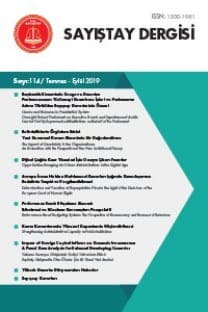Avrupa Sayıştayı İle Üye Devlet Yüksek Denetim Kurumları Arasındaki İlişki
Avrupa Sayıştayı, Avrupa Birliği AB bütçesini ve mali yönetimini bağımsız bir şekilde denetlemekle yükümlüdür. Avrupa Sayıştayı yaptığı denetimlerle AB’nin mali yönetiminin geliştirilmesine, AB üyesi devletlerin vatandaşlarının mali çıkarlarının korunmasına ve mali saydamlık ile hesap verebilirliğin iyileştirilmesine katkıda bulunmaktadır. Çalışmada Avrupa Sayıştayının üye devlet yüksek denetim kurumları YDK ile olan ilişkisinin boyutunun ve yaşanan sorunların tespit edilmesi amaçlanmaktadır. Avrupa Sayıştayı ile üye devlet YDK’ları arasında hiyerarşik olmayan bir işbirliği ve koordinasyon vardır. Avrupa Sayıştayı ile üye devlet YDK’ları arasında ortak denetimden, kurumsal ilişkilerin yapısından ve birliğe üye âdemi merkeziyetçi devletlerin yönetim sistemlerinden kaynaklanan sorunlar mevcuttur.
Anahtar Kelimeler:
Avrupa Sayıştayı, Denetim, Yüksek Denetim Kurumu YDK , Avrupa Birliği AB
THE RELATIONSHIP BETWEEN EUROPEAN COURT OF AUDITORS AND THE SUPREME AUDIT INSTITUTIONS OF MEMBER STATES
European Court of Auditors ECA is responsible for the independent audit of the European Union EU budget and financial management. With the audits, ECA contributes to the development of the financial management of the EU, protection of the financial interests of the citizens of EU member states, and improvement of fiscal transparency and accountability. This study aims to determine the extent of the relationship between ECA and the Supreme Audit Institutions SAIs of the member states and the problems encountered. There is a non-hierarchical collaboration and coordination between ECA and the SAIs of the member states. There are some problems between ECA and the SAIs of the member states due to joint audits, the structure of institutional relations and administrative systems of the decentralised member states.
Keywords:
European Court of Auditors ECA , Audit, Supreme Audit Institution SAI , European Union EU,
___
- ACIJ (2020), The Basics of Supreme Audit Institutions-Citizen Engagement, Asociación Civil por la Igualdad y la Justicia (ACIJ), https://eparticipatoryaudit.org/module-01/challenges-facing-supreme-auditinstitutions.php. (Erişim Tarihi: 04.04.2020)
- Aden, Hartmut (2015), “The European Court of Auditors and Its Relationship with National Independent Audit Institutions: The Evolving Audit Function in the EU Multilevel System”, The Palgrave Handbook of the European Administrative System, editör Michael W. Bauer ve Jarle Trondal, Palgrave Macmillan UK, London, s. 313–328.
- Ban, Cornel, ve Leonard Seabrooke (2017), “From Crisis to Stability: How to Make the European Stability Mechanism Transparent and Accountable”, Editör Leo Hoffmann-Axthelm, Transparency International EU Brussels.
- Botchway, Francis (2006), Documents in International Economic Law, Routledge, London and Newyork.
- Bourn, Sir John (2007), Public Sector Auditing: Is it Value for Money?, John Wiley & Sons, Inc.Hoboken, NJ, USA.
- Caldeira, Vítor (2008), “The European Court Of Auditor’s Perspective On The Management And Control Of EU Funds”. Polytechnical Studies Review, VI (10), s. 7–27.
- Castells, Antoni (2005), “External Audit Institutions: The European Court of Auditors and Its Relationship with the National Audit Institutions of the Member States”, Public Expenditure Control in Europe Coordinating Audit Functions in the European Union, editör Milagros García Crespo, Edward Elgar Publishing, Cheltenham, UK & Northampton, MA, USA, s. 127–47.
- Clark, Colin, Michael De Martinis, ve Maria Krambia-Kapardis (2007), “Audit Quality Attributes of European Union Supreme Audit Institutions”, European Business Review, 19 (1), s. 40–71.
- Consolidated Versions of the Treaty on European Union and the Treaty on the Functioning of the European Union (2012), Official Journal of the European Union, 26.10.2012, C 326/1.
- Contact Committee (2013), Coordinated Audit on the Enforcement of European Waste Shipment Regulation, Contact Committee of the Supreme Audit Institutions of the European Union.
- Contact Committee (2018), Audit Compendium Youth Unemployment and the Integration of Young People into the Labour Market, Contact Committee of the Supreme Audit Institutions of the European Union.
- Contact Committee (2019), Audit Compendium Public Health, Contact Committee of the Supreme Audit Institutions of the European Union.
- De Bondt, Anthony (2014), “Performance Audit by the European Court of Auditors: Time for a Rebalancing?”, University of Luxembourg, Master Thesis.
- Annual Report on the Implementation of the Budget (2019), Official Journal of the European Union, 8.10.2019, C 340/3.
- Decision No 38-2016 Laying Down the Rules for Implementing the Rules of Procedure of the Court of Auditors (2016), Erişim adresi: https://www. eca.europa.eu/Lists/ECADocuments/IMPLEMENTING_RULES_2016/ IMPLEMENTING_RULES_2016_EN.pdf
- Demirbaş, Tolga (2001), Sayıştaylar Tarafından Gerçekleştirilen Performans Denetimleri ve Türk Sayıştayı Uygulaması, Sayıştay Yayın İşleri Müdürlüğü, Araştırma/İnceleme/Çeviri Dizisi: 17, Ankara.
- Demirbaş, Tolga ve Özhan Çetinkaya (2018), Kamu Mali Yönetiminde Kontrol ve Denetim, Ekin Kitabevi, Bursa.
- Downes, Ronnie; Delphine Moretti ve Scherie Nicol (2017), “Budgeting and Performance in the European Union A Review in the Context of EU Budget Focused on Results”, OECD Journal on Budgeting, 1, s. 1–60.
- Dye, Kenneth M. ve Rick Stapenhurst (1998), “Pillars of Integrity: The Importance of Supreme Audit Institutions in Curbing Corruption”, WBI Working Papers, Report Number: 19684, Washington, DC.
- ECA (2017), Performance Audit Manual, Directorate of Audit Quality Control Committee (DQC), European Court of Auditors (ECA).
- ECA (2018), 2018 EU Audit in Brief Introducing the 2018 Annual Reports of the European Court of Auditors, European Court of Auditors (ECA), Luxembourg
- ISSN: 1300-1981
- Yayın Aralığı: Yılda 4 Sayı
- Başlangıç: 1990
- Yayıncı: T.C. Sayıştay Başkanlığı
Sayıdaki Diğer Makaleler
İnsani Gelişmişlik Endeksi İle Dolaylı-Dolaysız Vergiler Arasındaki İlişki: Türkiye Örneği
İsmail CİĞERCİ, Rabia Tuğba EĞMİR
Pandemi Sürecinin Yüksek Denetim Dünyasına Etkileri
Avrupa Sayıştayı İle Üye Devlet Yüksek Denetim Kurumları Arasındaki İlişki
Süleyman DİKMEN, Hüseyin Güçlü ÇİÇEK
Yüksek Denetim Kurumlarının Yargısal İşlevleri ve INTOSAI Standartlarında Yargının Temel İlkeleri
KAMU DENETİMİNDE PERFORMANS ÖLÇÜMÜ VE YÜKSEK DENETİM KURUMLARI YDK İÇİN GÜÇLÜKLERİ
Küreselleşme ve Savunma Harcamaları Arasındaki İlişkinin İncelenmesi
